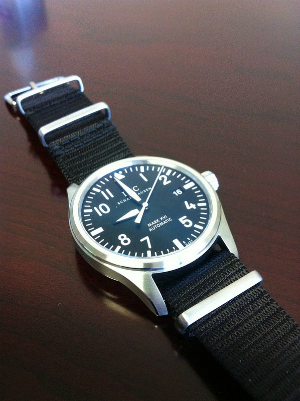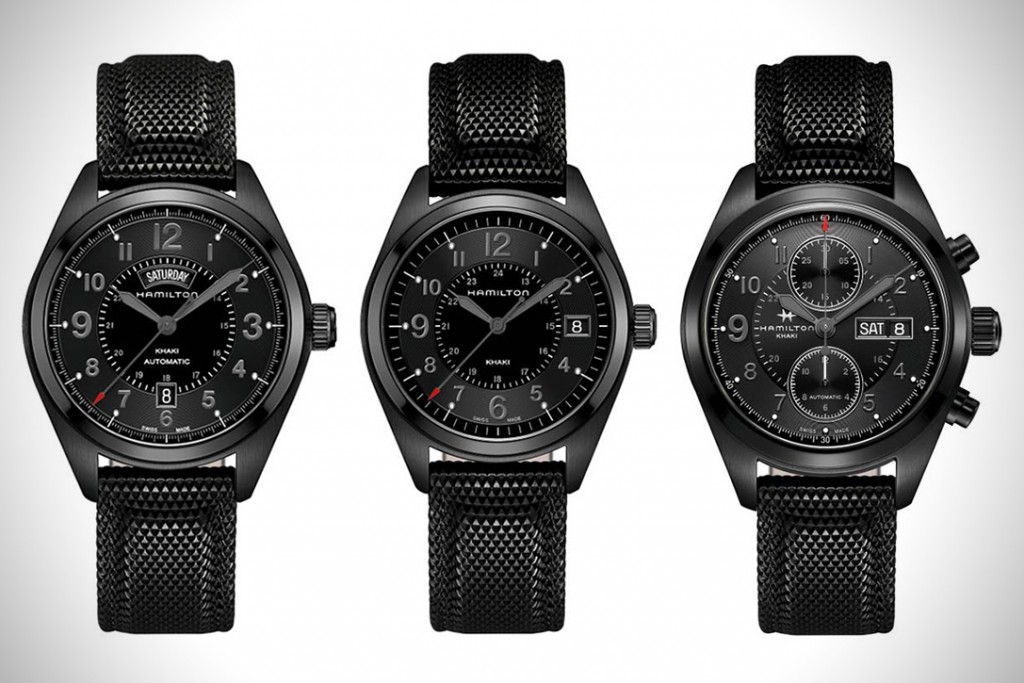As far as myself and my friends go we are purely collectors and enthusiasts but figured it is worth putting something together so other people with an interest in military watches can get a general background to the various watches favoured by the military, police, security industry and special forces. This site unlike most you visit is not going to try and sell you anything which probably makes a change! For me personally (Ian) I have a tendency to buy either military watches or something which is not actually military but has a pedigree and the looks of a military watch for example my IWC MK XVI which definately has the pedigree or alternatively a G-Shock which I own that is ideal for heavy duty use and can survive almost anything I throw at it. What is important to consider is that even if governments could afford the leading brands issued by countries such as the UK and Germany in the past it would not make economic sense when the models from Citizen, MWC, Pulsar, Seiko and Marathon are just as suitable and vastly cheaper.Most of the watches we own live in display cases but my friends and myself periodically use most of them. Of course no armed forces today could afford to issue a watch of the quality of the Rolex, Omega and IWC models of the past and even CWC is becoming too costly for most UK MOD contracts, as a point of interest in many countries they tend to leave the troops to source their own watches and hopefully this site will be helpful to them too to ensure they get something that is fit for purpose.

Of course for my friends and myself it’s a simple case that we often like a particular watch and add it to our collections then spend two weeks arguing over the merits and drawbacks of the particular model in the local bar! I still can’t figure why I have 27 watches when I always wear either the IWC, Rolex Deep Sea or the MWC classic Aviator which is very robust and a damn site cheaper than the IWC which it resembles to a degree but is much larger at 47mm excluding the crown where the IWC is only 39mm so I use the MWC day to day and it survives well which is the primary consideration also the Rolex gets a lot of use too. Of course the watches are one thing but straps are another area of interest to military watch enthusiasts and it is also an area which is seeing an ever increasing variety of variants. As for me personally I have a tendency to use NATO straps and one of the first things I did with my own IWC XVI was put it on a NATO strap which I have favoured since my time in the military!
I think it looks great but my wife favoured the original calf leather strap. The other watch I use in extreme situations which would not suit any of the others is the Casio G-Shock DW6900MS which although not a military watch as such is certainly fit for purpose and popular with serving military. I think the attraction my friends and myself have to military watches is because the look is very distinctive and striking, most having black dials and luminescent numerals and hands with either Tritium light sources or Superluminova. Another factor is we are all ex military or in some way connected to the military or police and again this pushes us towards our interests not just in the watches but other military kit such as image intensifiers and vehicles.
I am often asked which military watch is my all time favourite and I can answer that it has to be the IWC MK XI below. To me this embodies everything from looking right to being a high end well made product with a leading brand name. It is generally accepted as the most desirable military watch of all time but you will certainly need deep pockets to buy one these days although 18 years ago $600 would have secured a nice one now you can reckon with $4000 – $5000.
If I am asked which model it the hardest wearing its the Casio G-Shock DW6900MS below which whilst not a thing of great beauty is highly functional and has masses of features for a very low price. I think the Casio will be quite desirable in year to come because so many serving military tend to use them.
Returning to the historical models some of the most collectible military watch are British, German and American issue although many are actually Swiss made. The British army/navy/RAF models from IWC, Record, Cyma, Omega, Jaeger le Coultre, Lemania and Rolex are especially collectable and from the US, Elgin, Waltham and Bulova. Among other watches I have become aware of recently which are in huge demand is the Heuer (now Tag Heuer) German Luftwaffe Chronograph from the 1970s. Something that really caught my eye at an auction in Los Angeles was a Breitling Navitimer which was Iraqi Air Force issue this watch was a 1980’s Navitimer that Saddam Hussein issued to his pilots. The watch was engraved on the case back with the air force insignia. I wonder what it went for? Whatever it was it was certainly not going to have been cheap!
The history of Military watches, as their name implies lies in the fact they were specifically developed for use by the armed forces. The first military watches were made for use on warships. It was the WWII that really moved things along with various high quality cockpit clocks (Borduhren in German) emerging from companies such as IWC and Junghans this site is worth a look it has cockpit clocks and all sorts of odds and ends In the case of Navigator watch design timing was critical, the seconds bezel allowed the pilot to synchronize the second hand with correct and exact reference time before takeoff, and to make manual corrections to radio time signals while in flight, thus eliminating any “chronometer error” and the navigational errors that could result.
Split second timing and high degrees of accuracy continued to be vital in both military technology and military watches. The hack feature was developed enabling two or more military watches to be synchronised hence you will often hear the words in military films “synchronise watches”

Strangely the US tended to opt for smaller watches which were often as small as 30mm where Germany went for face sizes of 55mm or more, in fact the current IWC Pilots model The IWC Big Pilot watch is perhaps the ultimate mans sport watch on the market today. In fact to call it a sports watch is an injustice since the Big Pilot Watch is really a genuine Pilots timepiece. IWC first developed Pilot’s Watches in the 1930’s, launching the initial model in 1936. Early aviation pioneers all faced the same problem when it came to measuring the time. Pilots relied on oversized pocket watches to track their flight time and fuel consumption, but these pocket watches were cumbersome and difficult to access meaning they frequenty worked on guesstimates – far from ideal but compare it with today’s nightmare of finding your cellphone when its ringing in a pocket when you are driving at 100mph (160kph) plus (only where laws allow of course!) and you get the idea.
IWC attacked the problem by taking the pocket watch and designing a version that would fit on the pilot’s wrist over his flight suit. The first version of the Pilot watch was massive as we saw above. IWC designed a 55mm case with a black dial, high-contrast luminous hands, and a rotating glass bezel. This glass bezel had an arrow which the pilot used to measure flight time. Pilots attached the watch to their wrist using an oversized long leather strap.
Today the Big Pilot’s watch is smaller than the original version but still massive compared to other large sport or pilot watches on the market. Measuring 46.2 mm IWC’s Big Pilot watch is similar to the original in appearance with the original black dial design but they have added a date window at six o’clock and a power reserve indicator at three o’clock. With a seven day power reserve the Big Pilot Watch is in a class of its own.
Interestingly in light of supplies to the RAF it is worth noting that in Japan Seiko produced a huge number of military watches for the Japanese Army, Airforce and Navy in WWII. These watches were also very large especially when you consider the heigt of the average Japanese soldier at the time. These watches averaged around 49mm in diameter.
The Cold War 1945-1990
Toward the end of WWII with the advent of the Jet age accuracy and performance demands grew rapidly. To highlight the extent of this we need to look at the fact that a Lockheed Starfighter F- 104G from the 1950s was capable of 2334 km/h (1458mph) the fastest plane to see general service in WWII (excluding the Rocket Powered Messerschmitt Komet at 960km/h (600mph) was the Messerschmitt ME262 Jet Fighter with a top speed of 870 km/h (543mph) already advances in speed had been significant only 4 years before aircraft such as the Hawker Hurricane and Messerschmitt 109 were capable of speeds between 520km/h and 570 km/h (325/360mph) depending on the exact version of the aircraft . The increases in aircraft performance over such a short space of time mean’t that Chronographs and other precision instruments were vital.
The Cold War military watches were much larger in size than the average American navigators timepieces before them. Averaging 36mm in diameter they has reached the same dimensions which are familiar today. These hand-wound watches were expected to be water-resistant to 20 feet, including water-resistance under low-pressure at operational altitudes. Nearly all of these Cold War models were Swiss Made except for exceptions like the British Made Smith’s W10 which has the distinction of being the last mechanical watch actually manufacturer in the United Kingdom for supply to the military. These Smith’s W10’s were everywhere in the early to mid 1990’s at reasonable prices but are now hard to find at a reasonable price.
After these watches the W10 pattern was manufactured by CWC, Hamilton and MWC. Hamilton ceased production in the early 1970’s and production was continued by Cabot Watch Co better know by the initials CWC. The CWC W10 is still
made today by CWC and MWC also continue to manufacture this model in hand wound variants. The CWC and MWC have both been made in automatic variants but currently neither are available.
At this point the story pretty much ends because we now come to the watches we are all familiar with. Albeit in earlier variants but from the late 1970s onwards the watches took on the form we recognise today with some changes such as the introduction of Self Luminous Tritium Vials (GTLS) etc but in appearance they have changed little in the last 30 years. There are of course some non issue models such as G-Shock favoured by serving military which are very contemporary in appearance but the standard G10 looks much as it did in 1980.
Anyway browse the site and if you can think of anything interesting that we can add that would be of interest to collectors about a watch you know or own just send the details in and we would be glad to include it with the appropriate acknowledgment if you wish. Just send me a quick email to ian.crowley@military-watches.net




